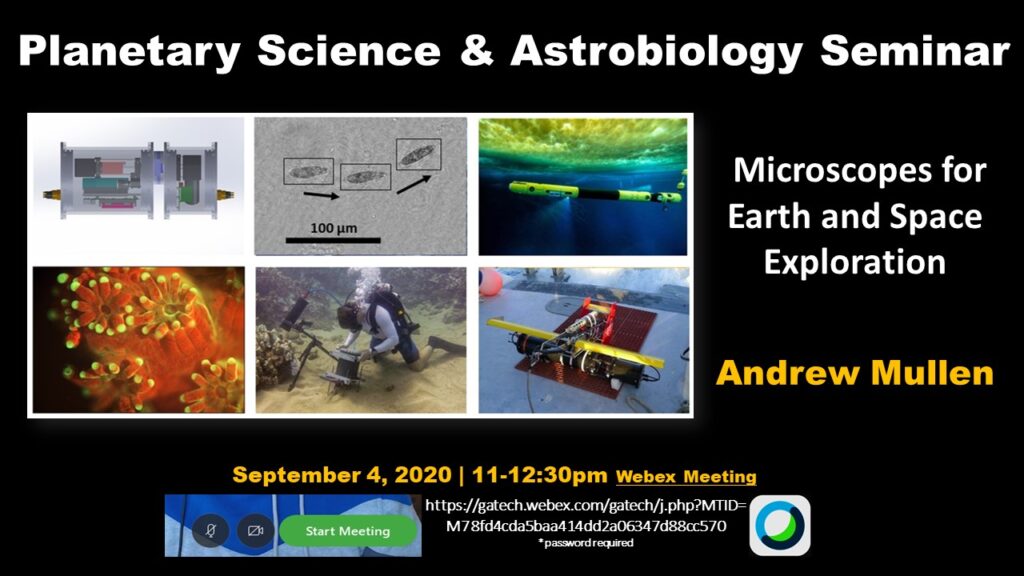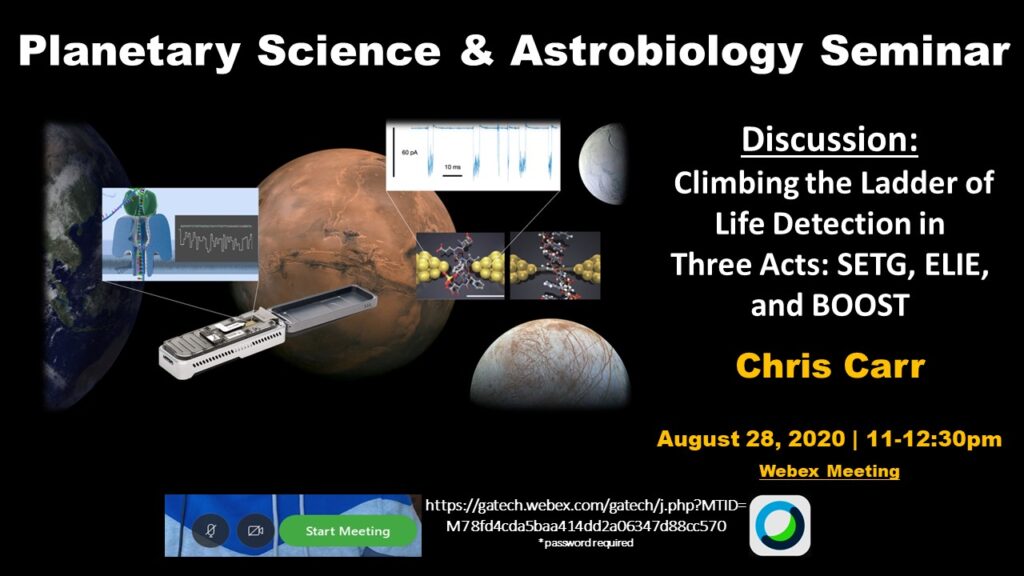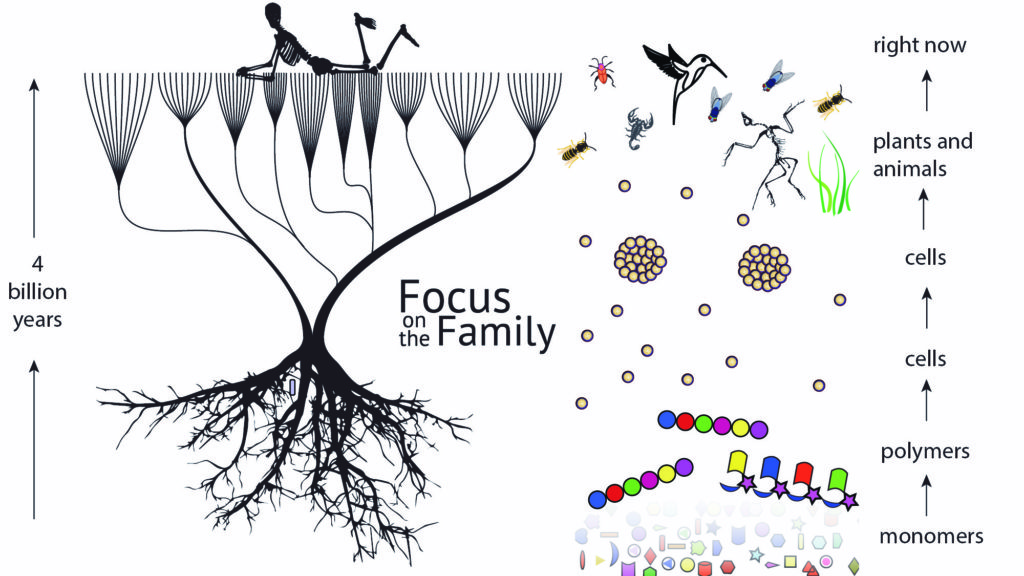Please check the AbSciCon 2021 website for all the details.
Join the AbSciCon Facebook page here.



A microscope for life detection is a top candidate instrument for ocean world and other planetary missions. Microscopes developed for ocean, earth, and space exploration have significant overlap; with analog terrestrial environments offering excellent settings to test techniques potential for space application.
In this talk I will introduce basic principles of microscopic imaging and discuss the application of microscopes for life detection and environmental exploration. I will then present several different microscopic imaging systems developed for both oceanographic exploration and planetary missions. This will include details on a submersible digital holographic microscope (DHM) being developed for the underwater robot Icefin, results from benthic underwater microscopes used to observe seafloor organisms, and towed systems for imaging plankton. At then end of this talk I hope you will have a better understanding of the capabilities of microscopes, their history of use in space and ocean applications, and future potential.

ExplOrigins & Astrobiology Primer Community Review
Speaker: Maryam Khademian
Affiliation: University of Illinois, Department of Microbiology

Date: Friday, May 8, 2020 – 10:00am
Location: BlueJeans
Host: ExplOrigins Group
Title: Oxidative Stress in Anoxic Habitats
Abstract: Bacteroides thetaiotaomicron was examined to determine whether its obligate anaerobiosis is imposed by endogenous reactive oxygen species or by molecular oxygen itself. Previous analyses established that aerated B. thetaiotaomicron loses some enzyme activities due to a high rate of endogenous superoxide formation. However, the present study establishes that another key step in central metabolism is poisoned by molecular oxygen itself. Pyruvate dissimilation was shown to depend upon two enzymes, pyruvate:formate lyase (PFL) and pyruvate:ferredoxin oxidoreductase (PFOR), that lose activity upon aeration. PFL is a glycyl-radical enzyme whose vulnerability to oxygen is already understood. The rate of PFOR damage was unaffected by the level of superoxide or peroxide, showing that molecular oxygen itself is the culprit. The cell cannot repair PFOR, which amplifies the impact of damage. The rates of PFOR and fumarase inactivation are similar, suggesting that superoxide dismutase is calibrated so the oxygen- and superoxide-sensitive enzymes are equally sensitive to aeration. The physiological purpose of PFL and PFOR is to degrade pyruvate without disrupting the redox balance, and they do so using catalytic mechanisms that are intrinsically vulnerable to oxygen. In this way the anaerobic excellence and oxygen sensitivity of B. thetaiotaomicron are two sides of the same coin.
Please join us in congratulating Alex Sessa, the first-ever recipient of a GT Astrobiology Graduate Certificate!
Read Alex’s sci comm project here.

For their semester-long science communication capstone project, fifteen Georgia Tech graduate students enrolled in the Astrobiology Graduate Certificate Program published content for Hypothesis Browser, an online tool for hypothesis-based literature searches, designed to capture the state of knowledge around the science of astrobiology and life detection.
Hypotheses were diverse in scope, ranging from planetary formation, to origins of life, to exoplanets, to icy moons, to the evolution of Earth and life. A full list of hypotheses and webpage links is below.
This project was a collaboration between Georgia Tech Astrobiology Graduate Certificate Program, Graham Lau at Blue Marble Space Institute of Science, and Andrew Pohorille at NASA Ames.

Planetary Formation
Reilly Brennan: Solar System Formation
Origins of Life
Tyler Roche: Information Polymers
Rebecca Guth-Metzler: Nucleobases
Taylor Plattner: Organics at Hydrothermal Vents
Exoplanets
Pengxiao Xu: Gaseous biosignatures on exoplanets
Worlds of the Solar System
Elizabeth Spiers: Europa ice thickness
Evolution of Earth and Life
Maria Catalina Granada: Panspermia
Zijian Li: Manganese and Oxygen Leah O’Rourke: Cretaceous–Tertiary mass extinction
GT Biochemistry Professor Loren Williams will be presenting “Voyage from the Gates of the Hadean – Origins of Life Research at Georgia Tech” at the Atlanta Science Tavern on Saturday February 22, 2020 at 7pm at Manuel’s Tavern. Details and RSVP here and below.

– This event is a production of the Atlanta Science Tavern.
– It is free and open to the public.
– Seating is on a first-come basis.
– RSVPs are not required to attend nor do they reserve seats.
– Doors open at 6:00 pm for early arrival.
– Gather for dinner by 7:00.
– The evening’s presentation gets under way around 7:45.
– Parking at Manuel’s has changed; refer to the note below for details.
__________
Loren Williams, Professor
School of Chemistry and Biochemistry
Georgia Institute of Technology
The origin of life (OOL) took place around 4 billion years ago, soon after the Earth cooled in the Hadean Eon. Water-based chemistry converted small building blocks to large polymeric molecules. Polymers have incredible properties, including ability to form assemblies. Polymers can assemble into compartments, fibers, enzymes and motors and can store and transduce information.
We have models, that are testable by experiment, to explain how increasing complexity of polymers led to simple microbial cells. For nearly 3 billion years microbes ruled the planet. Complex plants and animals are relatively recent branches on the tree of life.
The OOL can be studied from the bottom up (using chemical principles) or from the top down (mining information from biological systems). In this presentation I will discuss progress from long-running efforts at Georgia Tech that use both top-down and bottom-up approaches to unravel the OOL.
Consideration of OOL forces us to frame and confront the most profound and vexing questions in science and philosophy. The OOL tests our understanding of geological, chemical and biological principles and unsettles our sense of place in the universe.